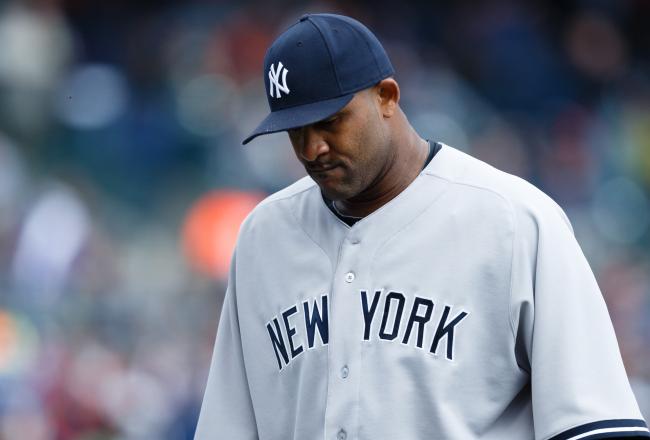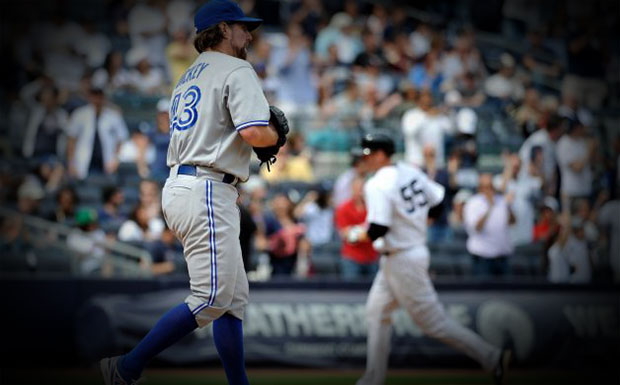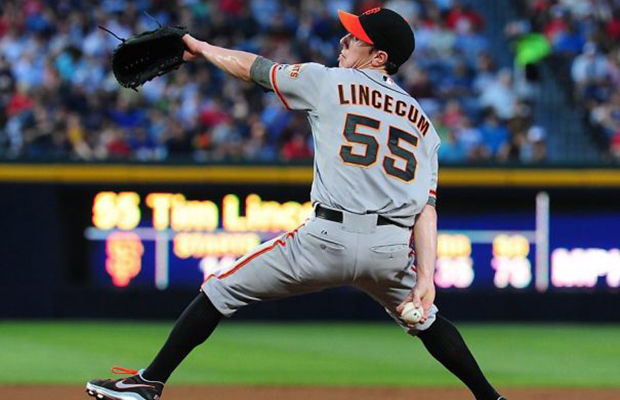Every year there are a handful of pitchers who fans would like to give up on. Whether it be injuries, age, poor performance, or some combination of the three, these hurlers have caused baseball aficionados to lose faith in them. 2013 saw John Lackey and Scott Kazmir rescue their careers by having strong seasons. These players likely went undrafted in most fantasy leagues. The Cleveland Indians brought Kazmir in on a minor league deal, and the Boston Red Sox had all but given up on Lackey.
Looking forward to 2014, which pitchers are good bounceback candidates?
 C.C. Sabathia was perhaps baseball’s most productive pitcher from 2006-12. Over that span, he posted 41.6 fWAR and a 72 ERA-, numbers that only Roy Halladay could match. However, the big lefty suffered from gopheritis in 2013, surrendering 28 home runs in 32 starts and authoring a 116 ERA-. His fastball velocity, which had dipped significantly from 2011 to 2012, fell again, and it averaged just 91.1 miles per hour.
C.C. Sabathia was perhaps baseball’s most productive pitcher from 2006-12. Over that span, he posted 41.6 fWAR and a 72 ERA-, numbers that only Roy Halladay could match. However, the big lefty suffered from gopheritis in 2013, surrendering 28 home runs in 32 starts and authoring a 116 ERA-. His fastball velocity, which had dipped significantly from 2011 to 2012, fell again, and it averaged just 91.1 miles per hour.
 Dan Haren has also served up too many home run balls the past two seasons. After a stretch from 2007-2011 where he pitched to a 78 ERA- with strikeout and walk rates of 22.0 percent and 4.7 percent respectively, Haren has a 118 ERA- in the last two years. The main reason is an HR/FB ratio of 13.o percent, compared to a 9.1 percent mark in his prime years. Now some of this is likely due to a diminishing fastball, but HR/FB ratio has a year-to-year correlation of just .11, so there is some randomness involved.
Dan Haren has also served up too many home run balls the past two seasons. After a stretch from 2007-2011 where he pitched to a 78 ERA- with strikeout and walk rates of 22.0 percent and 4.7 percent respectively, Haren has a 118 ERA- in the last two years. The main reason is an HR/FB ratio of 13.o percent, compared to a 9.1 percent mark in his prime years. Now some of this is likely due to a diminishing fastball, but HR/FB ratio has a year-to-year correlation of just .11, so there is some randomness involved.
Furthermore, Haren dealt with back and shoulder issues during much of the first half of the season where he managed a bloated 5.61 ERA. Over the second half, his ERA was a respectable 3.52. Haren’s strikeout rate has dipped a little to 19.9 percent in the last two years, but his walk rate remains the same. Pitching in spacious Dodger Stadium, Haren could manage an ERA in the 3.50 range, which would make him a steal for the Dodgers.
 R.A. Dickey pitched through a nagging back injury in 2013, and his numbers suffered. A year after authoring a 2.73 ERA with strikeout and walk rates of 24.8 percent and 5.8 percent, respectively, his ERA shot up to 4.21, and his strikeout rate fell to 18.8 percent.
R.A. Dickey pitched through a nagging back injury in 2013, and his numbers suffered. A year after authoring a 2.73 ERA with strikeout and walk rates of 24.8 percent and 5.8 percent, respectively, his ERA shot up to 4.21, and his strikeout rate fell to 18.8 percent.
His health appeared to improve in the second half, and his knuckleball velocity (which interestingly enough is key to his success) picked up. Dickey’s strikeout rate improved to 21.5 percent from 16.8 percent, and subsequently, his ERA dropped from 4.69 to 3.56. Unlike last season where he pitched in the World Baseball Classic, Dickey will have a full offseason to recover.
 In his first year after signing a four year, $52 million deal with the Chicago Cubs, Edwin Jackson authored a 129 ERA-, his worst mark since the 2007 season. He had a strand rate of 63.3 percent, more than seven points below his career average, and the .322 in-play batting average hitters managed was almost 15 points more than his career rate. Jackson’s 97 FIP- was essentially the same as the previous year.
In his first year after signing a four year, $52 million deal with the Chicago Cubs, Edwin Jackson authored a 129 ERA-, his worst mark since the 2007 season. He had a strand rate of 63.3 percent, more than seven points below his career average, and the .322 in-play batting average hitters managed was almost 15 points more than his career rate. Jackson’s 97 FIP- was essentially the same as the previous year.
Jackson’s fastball still averaged a healthy 93.1 miles per hour, and while his slider didn’t generate as many whiffs as the prior year, it still managed a swing and miss rate of 19.2 percent. His ERA was so out of line with his peripherals, that it shouldn’t be surprising if it drops by a full run in 2014.
 After four years of being one of the best pitchers in baseball, Tim Lincecum has managed a woeful 132 ERA- in the last two seasons. He managed a 7.3 percent HR/FB ratio from 2007-2011, a mark that his risen all the way to 13.3 percent in recent years. Though his control was never pinpoint, his walk rate of 10.0 percent is the fifth-highest since 2012. Lincecum still misses bats, as his 23.0 percent strikeout rate indicates, and his swinging strike rate has remained unchanged.
After four years of being one of the best pitchers in baseball, Tim Lincecum has managed a woeful 132 ERA- in the last two seasons. He managed a 7.3 percent HR/FB ratio from 2007-2011, a mark that his risen all the way to 13.3 percent in recent years. Though his control was never pinpoint, his walk rate of 10.0 percent is the fifth-highest since 2012. Lincecum still misses bats, as his 23.0 percent strikeout rate indicates, and his swinging strike rate has remained unchanged.
His fastball velocity has dipped by two miles per hour, so a return to top form is unlikely. With the loss of top stuff, he’ll likely give up a few too many home runs. Nevertheless, he still has good, and occasionally dominant stuff, as evidenced by his no-hit, thirteen strikeout performance against the San Diego Padres in July. By signing him to a two-year deal worth $35 million, the San Francisco Giants are clearly saying that they put more faith in his solid peripherals than his ugly ERA.
Baseball is an unpredictable game, more so than other sports. Fluctuations on HR/FB rates or hits on balls in play can drive a pitcher’s season one way or another. All of the above pitchers have solid track records, and their underlying numbers of 2013 give reason to believe that their cumulative resumes should be given more weight than the past year or two.
